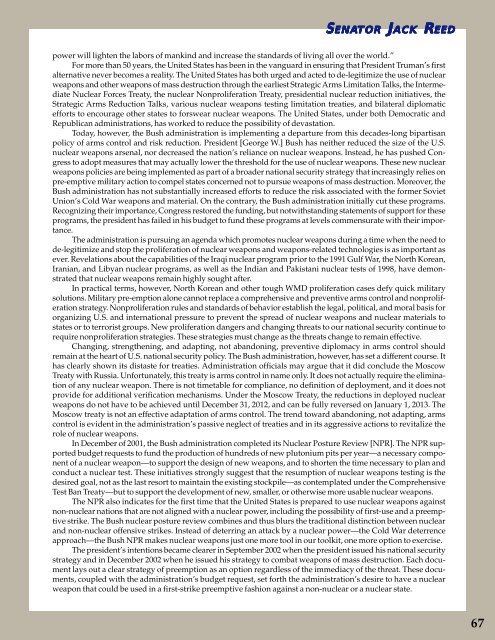test_pdf.pdf
Create successful ePaper yourself
Turn your PDF publications into a flip-book with our unique Google optimized e-Paper software.
SENA<br />
ENATOR<br />
JACK<br />
REED<br />
power will lighten the labors of mankind and increase the standards of living all over the world.”<br />
For more than 50 years, the United States has been in the vanguard in ensuring that President Truman’s first<br />
alternative never becomes a reality. The United States has both urged and acted to de-legitimize the use of nuclear<br />
weapons and other weapons of mass destruction through the earliest Strategic Arms Limitation Talks, the Intermediate<br />
Nuclear Forces Treaty, the nuclear Nonproliferation Treaty, presidential nuclear reduction initiatives, the<br />
Strategic Arms Reduction Talks, various nuclear weapons <strong>test</strong>ing limitation treaties, and bilateral diplomatic<br />
efforts to encourage other states to forswear nuclear weapons. The United States, under both Democratic and<br />
Republican administrations, has worked to reduce the possibility of devastation.<br />
Today, however, the Bush administration is implementing a departure from this decades-long bipartisan<br />
policy of arms control and risk reduction. President [George W.] Bush has neither reduced the size of the U.S.<br />
nuclear weapons arsenal, nor decreased the nation’s reliance on nuclear weapons. Instead, he has pushed Congress<br />
to adopt measures that may actually lower the threshold for the use of nuclear weapons. These new nuclear<br />
weapons policies are being implemented as part of a broader national security strategy that increasingly relies on<br />
pre-emptive military action to compel states concerned not to pursue weapons of mass destruction. Moreover, the<br />
Bush administration has not substantially increased efforts to reduce the risk associated with the former Soviet<br />
Union’s Cold War weapons and material. On the contrary, the Bush administration initially cut these programs.<br />
Recognizing their importance, Congress restored the funding, but notwithstanding statements of support for these<br />
programs, the president has failed in his budget to fund these programs at levels commensurate with their importance.<br />
The administration is pursuing an agenda which promotes nuclear weapons during a time when the need to<br />
de-legitimize and stop the proliferation of nuclear weapons and weapons-related technologies is as important as<br />
ever. Revelations about the capabilities of the Iraqi nuclear program prior to the 1991 Gulf War, the North Korean,<br />
Iranian, and Libyan nuclear programs, as well as the Indian and Pakistani nuclear <strong>test</strong>s of 1998, have demonstrated<br />
that nuclear weapons remain highly sought after.<br />
In practical terms, however, North Korean and other tough WMD proliferation cases defy quick military<br />
solutions. Military pre-emption alone cannot replace a comprehensive and preventive arms control and nonproliferation<br />
strategy. Nonproliferation rules and standards of behavior establish the legal, political, and moral basis for<br />
organizing U.S. and international pressure to prevent the spread of nuclear weapons and nuclear materials to<br />
states or to terrorist groups. New proliferation dangers and changing threats to our national security continue to<br />
require nonproliferation strategies. These strategies must change as the threats change to remain effective.<br />
Changing, strengthening, and adapting, not abandoning, preventive diplomacy in arms control should<br />
remain at the heart of U.S. national security policy. The Bush administration, however, has set a different course. It<br />
has clearly shown its distaste for treaties. Administration officials may argue that it did conclude the Moscow<br />
Treaty with Russia. Unfortunately, this treaty is arms control in name only. It does not actually require the elimination<br />
of any nuclear weapon. There is not timetable for compliance, no definition of deployment, and it does not<br />
provide for additional verification mechanisms. Under the Moscow Treaty, the reductions in deployed nuclear<br />
weapons do not have to be achieved until December 31, 2012, and can be fully reversed on January 1, 2013. The<br />
Moscow treaty is not an effective adaptation of arms control. The trend toward abandoning, not adapting, arms<br />
control is evident in the administration’s passive neglect of treaties and in its aggressive actions to revitalize the<br />
role of nuclear weapons.<br />
In December of 2001, the Bush administration completed its Nuclear Posture Review [NPR]. The NPR supported<br />
budget requests to fund the production of hundreds of new plutonium pits per year—a necessary component<br />
of a nuclear weapon—to support the design of new weapons, and to shorten the time necessary to plan and<br />
conduct a nuclear <strong>test</strong>. These initiatives strongly suggest that the resumption of nuclear weapons <strong>test</strong>ing is the<br />
desired goal, not as the last resort to maintain the existing stockpile—as contemplated under the Comprehensive<br />
Test Ban Treaty—but to support the development of new, smaller, or otherwise more usable nuclear weapons.<br />
The NPR also indicates for the first time that the United States is prepared to use nuclear weapons against<br />
non-nuclear nations that are not aligned with a nuclear power, including the possibility of first-use and a preemptive<br />
strike. The Bush nuclear posture review combines and thus blurs the traditional distinction between nuclear<br />
and non-nuclear offensive strikes. Instead of deterring an attack by a nuclear power—the Cold War deterrence<br />
approach—the Bush NPR makes nuclear weapons just one more tool in our toolkit, one more option to exercise.<br />
The president’s intentions became clearer in September 2002 when the president issued his national security<br />
strategy and in December 2002 when he issued his strategy to combat weapons of mass destruction. Each document<br />
lays out a clear strategy of preemption as an option regardless of the immediacy of the threat. These documents,<br />
coupled with the administration’s budget request, set forth the administration’s desire to have a nuclear<br />
weapon that could be used in a first-strike preemptive fashion against a non-nuclear or a nuclear state.<br />
67<br />
67
















